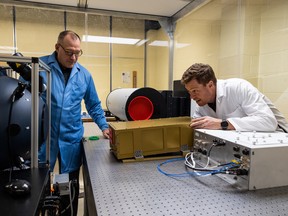U of S team crafts instruments for NASA, CSA climate satellite project
University of Saskatchewan professors Adam Bourassa and Doug Degenstein will be leading the $200-million climate science satellite project.

Article content
A cluster of satellites set to be launched by NASA and the Canadian Space Agency will be carrying equipment designed in Saskatchewan.
Professors Adam Bourassa and Doug Degenstein of the University of Saskatchewan’s Department of Physics and Engineering Physics will be co-leading the $200-million climate science satellite project to provide critical instruments for a large NASA and CSA satellite mission.
The program, Bourassa said, is “a once-in-a-decade kind of thing.
“This is a huge project,” Bourassa added.

The project will provide a Canadian and NASA satellite with cutting-edge Saskatchewan-made instruments to record aerosols, water vapour and clouds in the atmosphere.
“This will help us measure the effects of climate change and will allow us to build better models to predict future climate change and extreme weather effects,” Bourassa said.
“It will allow us to make better decisions on how to combat climate change.”
The Institute of Space and Atmospheric Studies (ISAS), to which the professors belong, has more than 30 years of experience in this field. In February 2001, for instance, the optical spectrograph and infrared imaging system (OSIRIS) was launched to measure the recovery of the ozone layer, Degenstein said.
“It has become one of the most successful projects of its kind. Canadian optical instruments, and specifically those that were developed here in Saskatchewan, have a worldwide reputation of being the best,” Degenstein said.
“We already have working prototypes of the instruments, but with the funding from the Canadian Space Agency, we will be able to build state-of-the-art instruments to go into space.”

The $200-million project was funded by the Canadian Space Agency and represents the biggest atmospheric measurement project ever. The professors and their team will develop two Canadian instruments on a Canadian satellite and a third instrument on a NASA satellite, all planned for launch in 2031.
“We may be leading this project, but it is our grad students and our collaboration with Saskatchewan companies that will make this project a success,” Degenstein said.
“This project will provide a huge boost for the next generation of engineers, physicists, environmental scientists and anyone working with technology. The expertise they develop working on a project like this is immeasurable.”
ISAS will build three instruments: ALI (aerosol limb imager), SHOW (spatial heterodyne observations of water) and TICFIRE (thin ice cloud In far infrared emissions) are focused on aerosol and water vapour measurements. The work is all part of the Canadian efforts in the HAWC mission (high-altitude aerosols, water vapour and clouds).
“Aerosols are small airborne particles that can come from dust, wildfires, volcanoes or human industry. They have a huge effect on how clouds develop and impact weather,” Bourassa said.
ALI and SHOW will be installed on the Canadian satellite and TICFIRE will be launched with the NASA satellite.
“There is a long way to go until the launch in 2031. After the satellites are up in space, we will be getting data from them daily, which we will use to better predict weather and improve our climate models,” Bourassa said.
The satellites are planned to be operational for five years after launch, but Bourassa pointed out that missions like these often get extended for as long as the satellite remains operational, which could be an extra 10 to 20 years in some cases.
“In 2031, we will proudly be able to say that there is some stuff in space with Saskatchewan fingerprints all over it,” Bourassa said, adding with a laugh: “Let’s just hope that there will be no fingerprints on the mirrors and lenses.”

The news seems to be flying at us faster all the time. From COVID-19 updates to politics and crime and everything in between, it can be hard to keep up. With that in mind, the Saskatoon StarPhoenix has created an Afternoon Headlines newsletter that can be delivered daily to your inbox to help make sure you are up to date with the most vital news of the day. Click here to subscribe.









Postmedia is committed to maintaining a lively but civil forum for discussion. Please keep comments relevant and respectful. Comments may take up to an hour to appear on the site. You will receive an email if there is a reply to your comment, an update to a thread you follow or if a user you follow comments. Visit our Community Guidelines for more information.